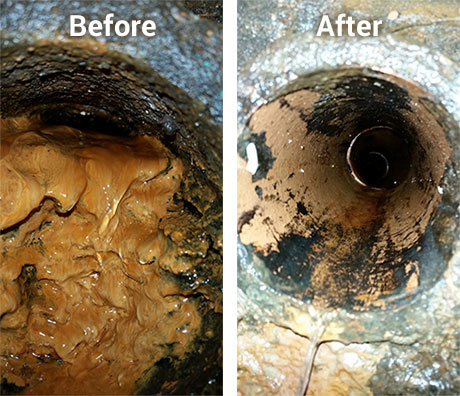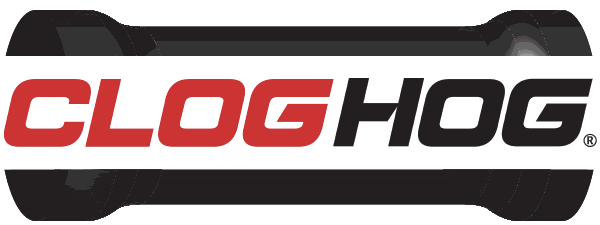Drain Cleaning Tips »
How Do I Remove a Iron Ochre Bacteria Clog?

Eliminating iron ochre bacteria clogs is usually a two-step process.
- The first step is to scrub the pipe walls and flush away the thick iron ochre residue that's inside the drain line, foundation drain ("drain tile"), sump pump line or fresh water supply line.
- A sewer jetter can help you scrub away sticky iron ochre and flush out the residue for more thorough cleaning of plastic and cast iron pipes from 1-1/2" to 4" ID.
 A Needle Nose™ drain cleaner is a sewer jetter with a tougher, braided steel jacket and a special compact nozzle tip that allows it to pass through elbows and transitions in more sizes and types of drains.
A Needle Nose™ drain cleaner is a sewer jetter with a tougher, braided steel jacket and a special compact nozzle tip that allows it to pass through elbows and transitions in more sizes and types of drains.- If the iron ochre residue has dried and solidified, use a sewer jetter with a nozzle that has a forward jet to help penetrate the hardened material.
- You should try a sewer jetter only if you can access an alternate drain opening in case the sewer jetter can't pass through any short radius elbows in the first drain opening that you try.
- Important: basement waterproofing drain tiles that are non-cylindrical, sold as WaterGuard, SealOnce and other brands, usually have rectangular corners that block sewer jetters and other cleaning tools. If you have a clogged drain tile that does not have a round cross-section, contact the installer for help to service or replace the drain tile.
 You can see the differences between a mechanical drain auger and a sewer jetter as they both take on a sticky clog in this 2 minute video.
You can see the differences between a mechanical drain auger and a sewer jetter as they both take on a sticky clog in this 2 minute video. To clean the pipe with a sewer jetter:
To clean the pipe with a sewer jetter:- Put on fluid resistant work gloves and eye protection. If you believe the pipe might contain chlorine shock or other agents, use extra care to avoid contacting your skin with the liquid or breathing mist from the drain.
- Make sure the work area is well ventilated. And, if you're using a gas-powered pressure washer, only operate it outdoors.
- Connect the drain cleaner to your pressure washer trigger gun. Then, start your pressure washer and guide the nozzle about a foot into the pipe opening before you squeeze the trigger to start the flow of water.
- Feed the drain cleaner into the pipe opening as you squeeze the trigger. Every few feet you should pull back about halfway and then continue moving forward to thoroughly scrub away the iron ochre residue.
- After you have finished cleaning the pipe, pull the drain cleaner out. Use care to release the trigger to stop the flow of water before the nozzle reaches the pipe opening.
 Our customer stories page has a review and these photos from a customer who removed an iron ochre bacteria clog.
Our customer stories page has a review and these photos from a customer who removed an iron ochre bacteria clog.
- After you thoroughly clean the pipe, it's usually necessary to treat the source of iron ochre bacteria to prevent the clog from coming back every few months.
- Chlorine shock and less corrosive oxalic acid compounds are sometimes used to kill the iron ochre bacteria – depending on local codes and whether your drain equipment can withstand these chemicals. To avoid breathing harmful mist or injuring your skin, do not use a sewer jetter in drains where these chemicals are present.
- Some higher-cost iron ochre treatments use less expensive oxalic acid (sometimes labeled as ethanedioic acid dihydrate) as their active ingredient. To verify a product's active ingredients, search online for its Material Safety Data Sheet (MSDS). Before using, verify the correct application and safety precautions with your agricultural extension office or other local authority.
- If the iron ochre is in your household water supply, sealing of wells and water sources against outside water incursion and thorough cleaning of any internal surfaces after exposure to the outside are often recommended after initial treatment.
- If you don't want to perform the iron ochre bacteria remediation yourself, consider hiring a good licensed plumber or waterproofing contractor to help.
- If you're not comfortable performing any of these steps, hiring a good, licensed service company could save you money in the long run. To find a good service company in your area:

- Start by asking family, friends and co-workers to recommend a company that has performed similar remediation for them.
- If you are unable to find a good recommendation from someone you know, search local directories like Google Maps, Yelp and CitySearch for companies nearby who have good online reviews. Don't always trust reviews from individuals who published very few other reviews, or from people who give only positive reviews to everyone. Be aware that good service companies sometimes get a small number of negative reviews for reasons that might not be relevant to your situation. Look for a company with several reviews that tell a positive, believable story about a situation that's similar to yours.
- After you find one or more service companies that seem to have a good reputation, search online for the company name and the names of individuals at the company, if known. Take into account both the positive and negative information that you find about the company.
- Be aware that good service companies sometimes have a backlog of several days during peak times when there are low temperatures, heavy rainfall or holidays. Sometimes heavy demand can be a sign of a company with lots of repeat customers.
If you have questions or comments please contact us.






